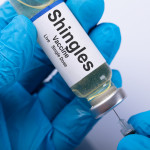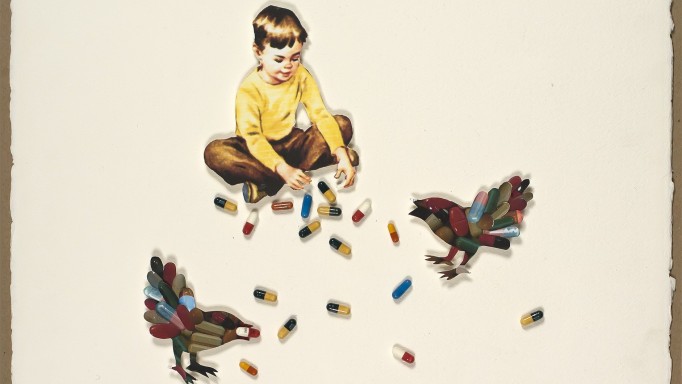Shingles is a skin condition caused by varicella-zoster virus (VZV), which also causes chickenpox. It is characterized by a painful rash, sometimes accompanied by flu-like symptoms. In some cases, it can lead to long-term nerve damage and pain.
VZV belongs to a larger human herpesvirus family that also includes the herpes simplex 1 and 2 viruses that cause oral and genital herpes, Epstein-Barr virus, cytomegalovirus and the HHV-8 virus that causes Kaposi sarcoma. Like other herpesviruses, VZV causes lifelong infection.
Most people acquire VZV during childhood. Chickenpox was once very common among children, but its incidence has fallen dramatically in the United States since VZV vaccination was introduced as a childhood immunization in 1995. Children with chickenpox usually fully recover, but it can cause more severe illness in immunocompromised children and in adolescents and adults.
Despite recovery, the virus is not eliminated. It establishes latent infection in nerves near the spine and can reactivate later in life to cause shingles (herpes zoster). According to the Centers for Disease Control and Prevention (CDC), about one in three adults will develop shingles in their lifetime. This typically occurs in older individuals, but people living with HIV—especially those with a low CD4 T-cell count—and other people with weakened immunity are susceptible at any age. Most people experience only one shingles outbreak, but immunocompromised people are more prone to recurrence.
Shingles vaccines can prevent reactivation and lessen the severity of outbreaks. Herpes is difficult to treat and cannot be cured, but scientists are working on better therapies.
How is VZV transmitted?
VZV spreads primarily through contact with fluid from chickenpox or shingles sores. Chickenpox spreads easily among children who have not been vaccinated. Shingles is not transmitted directly, but people with an active shingles outbreak can transmit the virus to others who have never been infected or vaccinated, and they can develop chickenpox. To prevent transmission, cover the rash until sores fully heal and avoid contact with immunocompromised people, premature infants and susceptible pregnant women.
Is there a vaccine to prevent shingles?
A vaccine called Varivax prevents initial VZV infection and chickenpox. (There is also a combination VZV, measles, mumps and rubella vaccine called ProQuad.) Varivax is recommended for children under 13 as well as for adolescents and adults who have never had chickenpox. Varivax lowers the risk of shingles but does not completely prevent it.
A different vaccine, called Shingrix, prevents shingles outbreaks in people who already carry the virus. It reduces the risk for shingles outbreaks and postherpetic neuralgia by more than 90%, and it is expected to provide protection for at least several years. An older, less effective live-virus shingles vaccine called Zostavax is no longer used in the United States.
The CDC recommends Shingrix for all adults ages 50 and older—including those who have already had shingles or previously received Varivax or Zostavax—and for younger adults with compromised immunity, including those living with HIV. Shingrix is given as a two-shot series spaced two to six months apart. The vaccine can cause injection site soreness and flu-like symptoms, but serious side effects are rare.
For people living with HIV, antiretroviral therapy suppresses HIV replication and allows immune function to recover, thereby lowering the risk for shingles outbreaks.
What are the symptoms of shingles?
People having a shingles outbreak may first develop fever, fatigue, headache or other flu-like symptoms, and they may experience skin pain, burning, itching or tingling—known as a prodrome—before breaking out in a rash.
While chickenpox is characterized by an itchy rash that can occur anywhere on the body, shingles typically has a more limited distribution, often appearing on one side of the body or face in a band-like pattern following the path of a nerve. The most commonly affected areas are the back, chest, abdomen, neck and face. The rash consists of fluid-filled blisters that are often itchy and painful, ranging from an aching or burning sensation to sharp or shooting pain. In some cases, shingles can also affect the eyes, inner ear, lungs and brain.
Shingles blisters typically heal within a few weeks, but the rash may last longer in people with weakened immunity. Pain may last for several weeks after the blisters heal. Some people develop long-lasting nerve damage known as postherpetic neuralgia, which can lead to chronic pain or numbness that can interfere with daily life. Shingles of the eye can lead to vision impairment, while shingles of the ear can cause hearing loss or vertigo.
How is shingles diagnosed?
The initial flu-like symptoms that signal an impending shingles outbreak can be mistaken for other conditions, but the pattern of the rash is distinctive, so it is often diagnosed based on appearance. To be certain, your doctor may take a sample of fluid from the rash with a swab to look for the virus. An antibody test can show if someone has been infected with VZV, but it is generally not used to diagnose chickenpox or shingles
How is shingles treated?
Like other herpes viruses, VZV cannot be cured. Antiviral medications may reduce pain, speed healing and lower the likelihood of recurrent outbreaks and postherpetic neuralgia, but they do not eliminate the virus.
Three related nucleoside analog medications—acyclovir (Zovirax), valacyclovir (Valtrex) and famciclovir (Famvir)—are used to treat shingles. Pills work best for mild to moderate outbreaks, while intravenous formulations may be used to treat severe symptoms. Treatment works best if it’s started as soon as possible after the first symptoms or prodromal signs. People who are prone to outbreaks may take lower doses to prevent recurrence. These oral antivirals are generally safe and well tolerated with few side effects.
VZV does not always respond to commonly used antivirals, and some people develop drug-resistant virus. This is more likely to occur among immunocompromised people. Because these antivirals are similar, people who develop resistance to one are likely to be resistant to the others as well. Intravenous foscarnet (Foscavir) may be used to treat acyclovir-resistant shingles, but it is toxic to the kidneys and requires close monitoring.
Beyond antivirals, over-the-counter medications such as ibuprofen and topical preparations can be used to relieve pain. Some people, especially those with postherpetic neuralgia, may need stronger prescription pain medications. Calamine lotion and oatmeal baths can help relieve itching. During an outbreak, keep sores clean and dry, as this helps speed up healing and prevents bacterial infection.
Researchers are studying new medications that might be more effective for shingles and postherpetic neuralgia. Visit ClinicalTrials.gov to learn what experimental therapies are being tested, and ask your doctor whether a clinical trial might be a good option for you.
Last Reviewed: August 21, 2023














